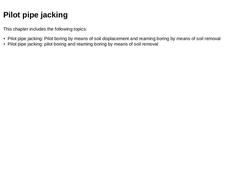
|
In general the following techniques of unmanned, steerable pilot pipe jacking, in the literature also known as guided boring, are applied, whereas the jacking is always carried out in two (Abschnitt 3.1.1.1) (Abschnitt 3.1.2) or a maximum of three (Abschnitt 3.1.1.2) sequential phases: - Pilot boring, by means of soil displacement and reaming boring by means of soil removal
Two-phase jacking (Abschnitt 3.1.1.1)
Three-phase jacking (Abschnitt 3.1.1.2)…
|
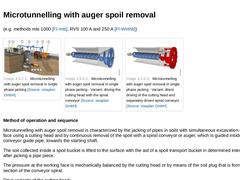
|
(e.g. methods mts 1000 [FI-mts], RVS 100 A and 250 A [FI-Wirthb]) |
(Image: Microtunnelling with auger spoil removal in single phase jacking)
|
(Image: Microtunnelling with auger spoil removal in single phase jacking - Variant: driving the cutting head with the spiral conveyor)
|
(Image: Microtunnelling with auger spoil removal in single phase jacking - Variant: direct driving of the cutting head and separately driven spiral conveyor)
|
Method of operation … |
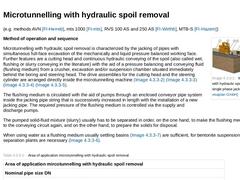
|
(e.g. methods AVN [FI-Herreb], mts 1000 [FI-mts], RVS 100 AS and 250 AS [FI-Wirthb], MTB-S [FI-Hazem]) (Image: Microtunnelling with hydraulic spoil removal in single phase jacking) Method of operation and sequence Microtunnelling with hydraulic spoil removal is characterized by the jacking of pipes with simultaneous full-face excavation of the mechanically and liquid pressure balanced working face. Further features are a cutting head and continuous … |
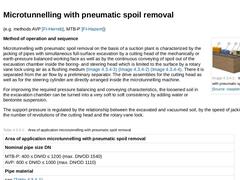
|
(e.g. methods AVP [FI-Herreb], MTB-P [FI-Hazem]) (Image: Microtunnelling with pneumatic spoil removal) Method of operation and sequence Microtunnelling with pneumatic spoil removal on the basis of a suction plant is characterized by the jacking of pipes with simultaneous full-surface excavation by a cutting head of the mechanically or earth-pressure balanced working face as well as by the continuous conveying of spoil out of the excavation chamber inside … |
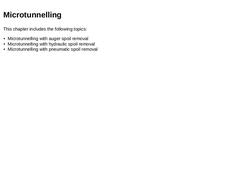
|
The unmanned, steerable microtunnelling techniques employed base generally on the principle of soil removal. Depending on the way of conveying the spoil, it is differentiated between: - Microtunnelling with auger spoil removal (Abschnitt 3.2.1)
- Microtunnelling with hydraulic spoil removal (Abschnitt 3.2.2)
- Microtunnelling with pneumatic spoil removal (Abschnitt 3.2.3)
In all cases the different soil- and rock types are taken into account by the different … |
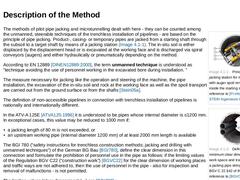
|
| (Image: Principle sketch of a jacking station for microtunnelling with auger spoil removal installed inside the starting shaft) | | (Image: Definition of the minimum clear dimensions for work space and traffic ways inside a jacking pipe string according to BGV C 22 §42 of the BG Bau with reference to [BGVC22] [Image: S&P GmbH] - Clear dimension profile in the form of a circular cross section) | | (Image: Definition of the minimum clear dimensions for … |
|
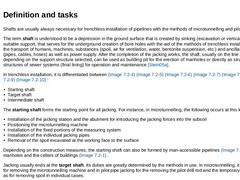
|
Shafts are usually always necessary for trenchless installation of pipelines with the methods of microtunnelling and pilot pipe jacking. The term shaft is understood to be a depression in the ground surface that is created by sinking (excavation or vertical boring), with suitable support, that serves for the underground creation of bore holes with the aid of the methods of trenchless installation and for the transport of humans, machines, substances (… |
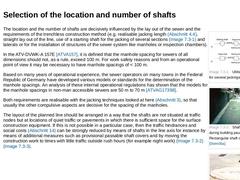
|
|
(Image: Utilisation of a shaft for several jackings [Stein05a])
|
|
(Image: Shaft coverings during building pauses - Rectangular shaft covering [Stein05a])
|
|
(Image: Shaft coverings during building pauses - Circular shaft covering [FI-KCMM])
|
The location and the number of shafts are decisively influenced by the lay out of the sewer and the requirements of the trenchless construction method (e.g. realisable jacking length (Abschnitt 4.4), straight … |
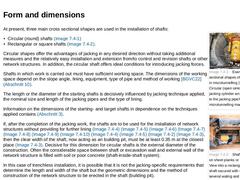
|
|
(Image: Examples of cross sectional shapes of starting shafts in microtunnelling [FI-Herreb] - Circular (open sinking shaft), jacking cylinder arranged parallel to the jacking pipe/to the microtunnelling machine)
|
|
(Image: Shaft support based on sheet planks or sheet piles - View into a rectangular starting shaft secured with sheet piles and several waling and brace layers (jacking pipe arranged in front of the pressure ring) [FI-Herreb])
|
|
(Image: … |
|
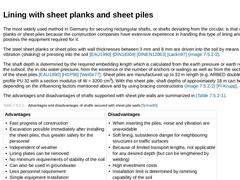
|
The most widely used method in Germany for securing rectangular shafts, or shafts deviating from the circular, is that of using sheet planks or sheet piles because the construction companies have extensive experience in handling this type of lining and usually also possess the equipment required for it. The steel sheet planks or sheet piles with wall thicknesses between 3 mm and 8 mm are driven into the soil by means of ramming, vibration (shaking) … |
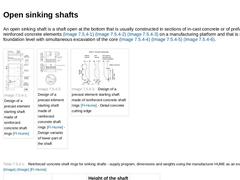
|
An open sinking shaft is a shaft open at the bottom that is usually constructed in sections of in-cast concrete or of prefabricated reinforced concrete elements (Bild 6.4.3) (Bild 6.4.3) (Bild 6.4.3) on a manufacturing platform and that is sunk to its foundation level with simultaneous excavation of the core (Bild 3) (Bild 3) (Bild 3). | (Image: Design of a precast element starting shaft made of reinforced concrete shaft rings [FI-Hume]) |
(Image: Design … |
|
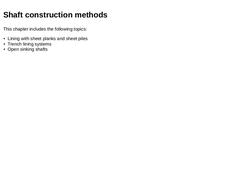
|
(Image: Methods for securing shafts [Stein05a]) Decisive for the selection of a method of shaft construction, i.e. the measures for sinking and securing of a shaft, can be, for example [Stein05a] : - Dimensions (length, width and depth of the shaft)
- Selected jacking method
- Geological and hydrogeological conditions
- Local conditions (e.g. available space, surface utilization, traffic loads)
- Environmental protection (limiting values of emissions during …
|
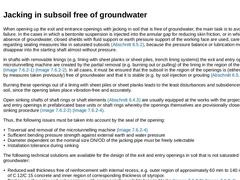
|
When opening up the exit and entrance openings with jacking in soil that is free of groundwater, the main task is to avoid ground failure. In the cases in which a bentonite suspension is injected into the annular gap for reducing skin friction, or in which, despite the absence of groundwater, closed shields with fluid support or earth pressure support of the working face are used, care must be taken regarding sealing measures like in saturated subsoils (… |
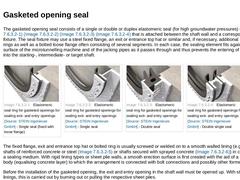
|
The gasketed opening seal consists of a single or double or duplex elastomeric seal (for high groundwater pressures) (Bild 6.5.2.1) (Bild 6.5.2.1) (Bild 6.5.2.1) (Bild 6.5.2.1) that is attached between the shaft wall and a correspondingly seal fixture. The seal fixture may use a steel fixed flange, an exit or entrance top hat or similar and, if necessary, additional intermediate rings as well as a bolted loose flange often consisting of several segments. … |
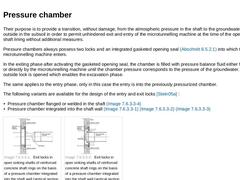
|
Their purpose is to provide a transition, without damage, from the atmospheric pressure in the shaft to the groundwater pressure outside in the subsoil in order to permit unhindered exit and entry of the microtunnelling machine at the time of the opening of the shaft lining without additional measures. Pressure chambers always possess two locks and an integrated gasketed opening seal (Abschnitt 6.5.2.1) into which the microtunnelling machine enters. |

|
(Image: Dewatering properties of different types of soils with water retention measures [Herth95]) The following measures are possible in order to prevent ground failure and groundwater inflows when creating and traversing the exit and entry openings [Stein05a] : - Open water retention
- Groundwater lowering
- Groundwater cut-off
The simplest solutions, when technically possible are water retention measures for lowering the groundwater level [Rappe96] [DIN18305]. |

|
Within the scope of microtunnelling and pilot pipe jacking a difference is made between the following phases of jacking [Konra01] : - Exiting (starting)
Exiting is the phase of jacking from the beginning of opening the lining or the start of the approach of the boring head to the in-situ subsoil up to the completion of all special measures. The sequence of the activities can be repeated when traversing an intermediate shaft.
- Excavation
Excavation is the …
|
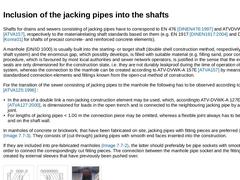
|
Shafts for drains and sewers consisting of jacking pipes have to correspond to EN 476 [DINEN476:1997] and ATVDVWK A 157E [ATVA157], respectively to the materialrelating shaft standards based on them (e.g. EN 1917 [DINEN1917:2004] and DIN V 4034-1 [Konra01] for shafts of precast concrete- and reinforced concrete elements). A manhole (DN/ID 1000) is usually built into the starting- or target shaft (double shell construction method, respectively shaft-… |
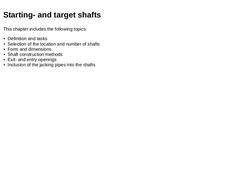
|
|
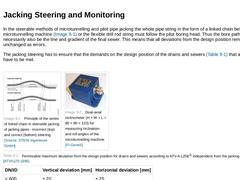
|
In the steerable methods of microtunnelling and pilot pipe jacking the whole pipe string in the form of a linked chain behind the microtunnelling machine (Bild 8) or the flexible drill rod string must follow the pilot boring head. Thus the bore path must necessarily also be the line and gradient of the final sewer. This means that all deviations from the design position remain almost unchanged as errors. The jacking steering has to ensure that the … |
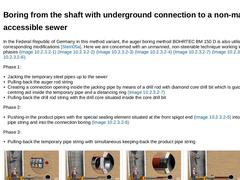
|
In the Federal Republic of Germany in this method variant, the auger boring method BOHRTEC BM 150 D is also utilised with corresponding modifications [Stein05a]. Here we are concerned with an unmanned, non-steerable technique working in three-phases (Bild 9.1.2.1) (Bild 9.1.2.1) (Bild 9.1.2.1) (Bild 9.1.2.1) (Bild 9.1.2.1) (Bild 9.1.2.1) (Bild 9.1.2.1). Phase 1: - Jacking the temporary steel pipes up to the sewer
- Pulling-back the auger rod string
- Creating …
|
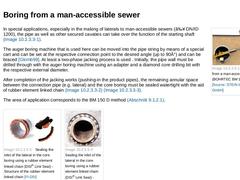
|
(Image: Boring a lateral from a man-accessible sewer (BOHRTEC BM 150 DT method)) In special applications, especially in the making of laterals to man-accessible sewers (≥ DN/ID 1200), the pipe as well as other secured cavaties can take over the function of the starting shaft (Bild 9.1.2.2). The auger boring machine that is used here can be moved into the pipe string by means of a special cart and can be set at the respective connection point to the … |
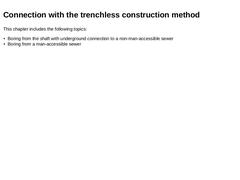
|
Here we are dealing with a combination of the trenchless installation of the lateral with the underground connection to the sewer. It is differentiated between two variants [Stein05a] : - Boring from the shaft with underground connection to a non-man-accessible sewer
- Boring from a man-accessible sewer core drilling machine rectangular and central to the axis of the sewer [FI-DS]
|
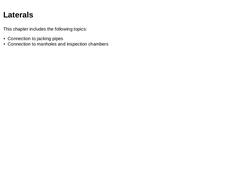
|
With the construction of the main sewer also drains should be produced. According to EN 752-1 [DINEN752d], a drain is defined as a "pipeline, usually underground, designed to carry wastewater and/or surface water from a source to a sewer." In literature and the regulations also the synonyms connection sewer, service pipe, building connection or lateral can be found. In the following, the term lateral is used. Laterals can be produced with the open-… |
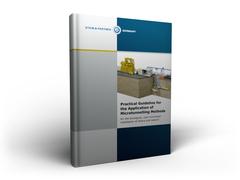
|
This manual is the first to provide a comprehensive, easy-to-understand overview of the possibilities of trenchless pipeline construction for installing non-accessible pipelines and sewers by means of pilot pipe jacking and microtunneling. In 15 chapters with 85 pictures and 26 tables, all important aspects to be considered during planning, construction and acceptance are presented in a practical and easy-to-understand manner, in addition to detailed descriptions of the procedures and methods. Furthermore, topics jacking pipes, geotechnical investigations, starting- and target shafts, obstacle problems, steering and monitoring, lateral connection, work safety and health protection, planning, and economic considerations are also covered. |